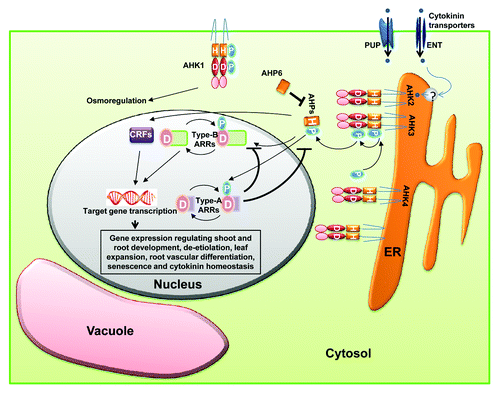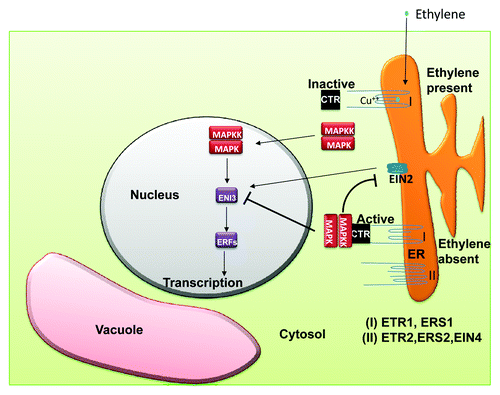Figures & data
Figure 1. Types of phosphorelay signaling in two-component systems. (A) The E. coli EnvZ-OmpR two component system includes a simple histidine kinase and a response regulator. Transfer of the phosphoryl group occurs from the conserved histidine at the transmitter domain of the HK to the conserved aspartate at the receiver domain of the response regulator. (B) The Yeast SLN1-YPD1-SSK1 two component system employs a hybrid histidine kinase which contains an additional receiver domain, a histidine containing phosphotransfer protein and a response regulator. It involves a multistep his to asp phosphorelay. (C) Plant two component systems have the same architecture as the yeast’s.

Table 1. HK genes identified in various plant species. The numbers shown here represent the total number of genes identified in the particular genome
Figure 2. Model for cytokinin signaling. Cytokinins are translocated by plasma membrane localized transporters and then by unknown mechanisms, enter into the ER lumen where their perception takes place. Cytokinin binding to their histidine kinase receptors triggers autophosphorylation at the conserved histidine residue. Then, the phosphoryl group is shuttled to the RR via the HpT. Type-B RRs are transcription factors which turn on the expression of cytokinin regulated genes as well as type-A RRs. The Type-A RRs are involved in repressing the cytokinin signaling via negative feedback loops. Alteration of target gene expression by type-B RRs results in cytokinin responses. AHK1, localized at the plasma membrane, perceives changes in osmolarity and via unknown mechanisms, mediate the corresponding physiological responses of the plant. For details, see text.

Figure 3. Model for ethylene signaling. Ethylene crosses the cell membranes presumably by passive diffusion and is perceived by receptors localized ER or Golgi (not shown in diagram). Two types of receptors, type-I and type-II, are present which are active and thus suppress the ethylene responses in the absence of the hormone. Binding of ethylene results in the inactivation of the type I receptors as well as the associated negative regulatory proteins, CTR1 and RTE1 (in Golgi, not shown in diagram). This activates a MAP kinase pathway which facilitates the ethylene response factors (ERFs) through the eventual activation of EIN3, EIL1. For details, see text.
